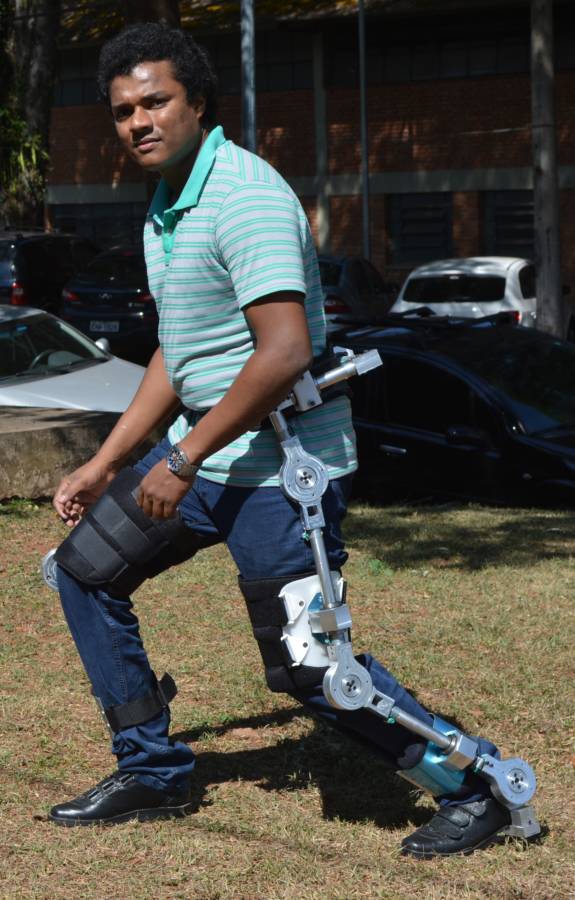UNEP magazine Robotic skeleton promises to make rehabilitation technology cheaper
Marcos de Amaral Jorge
In some arthropods, equivalent to spiders, scorpions and crabs, the construction accountable for supporting and defending very important organs isn’t contained in the physique – like our skeleton – however exterior the physique. These are the exoskeleton. The exoskeleton idea is now an concept being explored by researchers engaged on technology to rehabilitate sufferers with mobility points. At the Unesp campus in São João da Boa Vista, a analysis venture is creating a robotic exoskeleton aimed toward restoring decrease limb actions, with the primary concentrate on sufferers who’ve mobility disabilities due to a cerebrovascular accident (CVA).
The ExoTAO venture, as it’s known as, was developed by Professor Willian Miranda dos Santos since 2011, when he was nonetheless a grasp’s scholar supported by FAPSP on the Robotic Rehabilitation Laboratory of the School of Engineering of São Carlos, USP. Today he’s an affiliate professor. The predominant focus of this venture, which, as well as to USP, additionally has the Federal University of São Carlos (UFSCar) as a companion, is on sufferers with stroke penalties and incomplete spinal twine damage, whose situation requires a rehabilitation course of. . From the decrease limb. . A prototype of the exoskeleton is at present in operation and is at present being examined on folks with out mobility disabilities. But the aim is to use it in sufferers on a trial foundation later this yr.
Stroke is the main reason for dying in Brazil
Stroke is the main reason for dying in Brazil, and estimates from the Ministry of Health present that greater than two million individuals are dwelling with its penalties right this moment. Of these, greater than 500,000 folks have extreme disabilities. Most of those sufferers’ mobility and autonomy are compromised, and it’s essential to undergo an extended, common and sophisticated rehabilitation course of, which incorporates, for instance, dozens of physiotherapy and occupational remedy classes, as well as to frequent journeys to rehabilitation facilities.
Santos explains that the primary robotic gadgets developed for rehabilitation functions labored on imposing an excellent gait. That is, the machine guided the execution of the right motion, however didn’t require the affected person’s effort: he carried out the workout routines fully passively. Over time, this strategy proved ineffective. In order for the affected person to give you the chance to relearn how to transfer after a stroke, reorganization of the cerebral cortex is critical. “This reorganization is feasible provided that an effort is made on his half.” The engineer explains.
From the primary steps of the ExoTAO venture, the researchers set as considered one of their challenges the creation of a mechanism that will give you the chance to learn the depth required to carry out the motion by the affected person, however not to the extent that it replaces their effort. “It’s like a teacher-student relationship. The robotic should assist the affected person, however can’t carry out the motion for the affected person. It ought to assist to some extent. “The scholar have to be ready to do the task alone.” Santos compares.
In order to obtain an adaptive response from the machine to the trouble exerted by the affected person whereas offering security, the researchers outfitted the machine with a collection of elastic actuators, that are motors outfitted with springs situated in every of the joints of the exoskeleton. . By studying the affected person’s drive carried out by the algorithms, the actuators can calculate the drive depth that the exoskeleton ought to exert on the motion carried out by the affected person. The efficiency of the buildings was described intimately within the articles revealed within the scientific journal Practice of management engineering In 2019 and 2017. “ExoTAO permits you to make totally different contributions at totally different moments that make up a march. Santos explains that what defines it as a robotic machine is exactly the truth that it could actually purchase and adapt to data, exhibiting some extent of autonomy to make choices.
Another aim was to give the venture a modular construction. This permits the stimulators situated within the joints to be eliminated to meet every particular person’s remedy wants, thus permitting for individualized machine use and remedy.

Another characteristic is the opportunity of getting a collection of information concerning the affected person by way of the machine. For instance, the exoskeleton can present data on measuring the drive exerted by the particular person and the robotic throughout strolling, in addition to the affected person’s stride size and motion velocity, amongst different indicators.
However, incorporating this knowledge into affected person evaluation or designing rehabilitation protocols isn’t the experience of exoskeleton growth engineers. To care for this scientific space, this group enjoys the cooperation of researchers within the discipline of physiotherapy at UFSCar. Marcela de Abreu Silva Couto is at present doing a postdoctoral internship within the Robotic Rehabilitation Laboratory, however since 2013 she has been a part of the group and contributes to the scientific perspective of the initiatives. During his PhD, he evaluated the results of a robotic remedy session related to online game exercise in persistent stroke sufferers. This examine discovered optimistic outcomes.
Potential to speed up restoration
A associated difficulty raised on this work is its collaboration to design future protocols and replicate the usage of any such technological assets. Cotto explains that one of many differentiators of robotic rehabilitation is its potential to generate and make obtainable knowledge units that enable it to be used as an evaluation software. However, the researcher explains that there’s nonetheless a way to go to reconcile this knowledge with what’s already interpretable.
Part of the analysis performed by physiotherapists focuses on the correlation of those outcomes offered by the gear with the gold customary strategies at present used – for instance, gait evaluation utilizing a digicam. The concept is to develop not solely the gear itself, however all of this very wealthy enter of knowledge that the gear brings, and thus a dialog between the traditional practical checks that we already apply in physiotherapy and this technology. Create in growth. “, he explains.
This researcher notes that the rehabilitation means of an individual affected by motion limitations due to a stroke is often lengthy, tiring and demotivating, each for the affected person and for well being professionals. However, what researchers have discovered is that the usage of robotics has proven potential to velocity up the restoration course of.
Robotic rehabilitation has the attribute of offering intensive remedy. Depending on the gear and the way it’s used, extra hours are given to the affected person in contrast to the traditional remedy technique. This researcher, who has lately studied the usage of robotics in sufferers with Parkinson’s, says: typically in half an hour of utilizing robotic gear, a consequence equal to greater than three hours of regular rehabilitation is obtained.
Cotto stipulates that the usage of robotics ought to be seen as one other useful resource associated to rehabilitation and never as a magic resolution. “There isn’t any level in romanticizing a future the place folks sit in vehicles and get well. “We will at all times want an individualized perspective and the mix of a number of approaches in remedy.” It makes use of the idea of a therapeutic surroundings wherein technological assets equivalent to robots, video video games and digital actuality are used, however doesn’t abandon typical strategies.
The risk of cheaper entry to technology
The growth of a tool for robotic rehabilitation with nationwide technology additionally brings the prospect of constructing this remedy technique cheaper. The value of imported gear, in accordance to Santos, is likely one of the largest obstacles to making robotic rehabilitation extra accessible to most of the people. Commercial gadgets comparable to the one developed by the Unesp, USP and UFSCar staff at present value not less than €300,000, making them virtually inconceivable to buy, apart from some giant rehabilitation facilities.
In 2018, a patent was filed that highlighted the modular idea and construction of the exoskeleton, and lately the group has been engaged on turning the prototype right into a product. For this new section, Santos cites as the primary challenges the optimization of some elements so as to scale back their weight and create an optimized design that can assist commercialize it.
But, regardless of the very excessive costs, he says that the usage of robotic gadgets in rehabilitation has good causes to grow to be extra frequent sooner or later, supported by helpful points equivalent to confirmed effectiveness in bettering the rehabilitation of sufferers, the event of recent protocols. and remedy options with this useful resource and the method of together with synthetic intelligence within the determination making of gadgets.
Exoskeleton images: private assortment.



